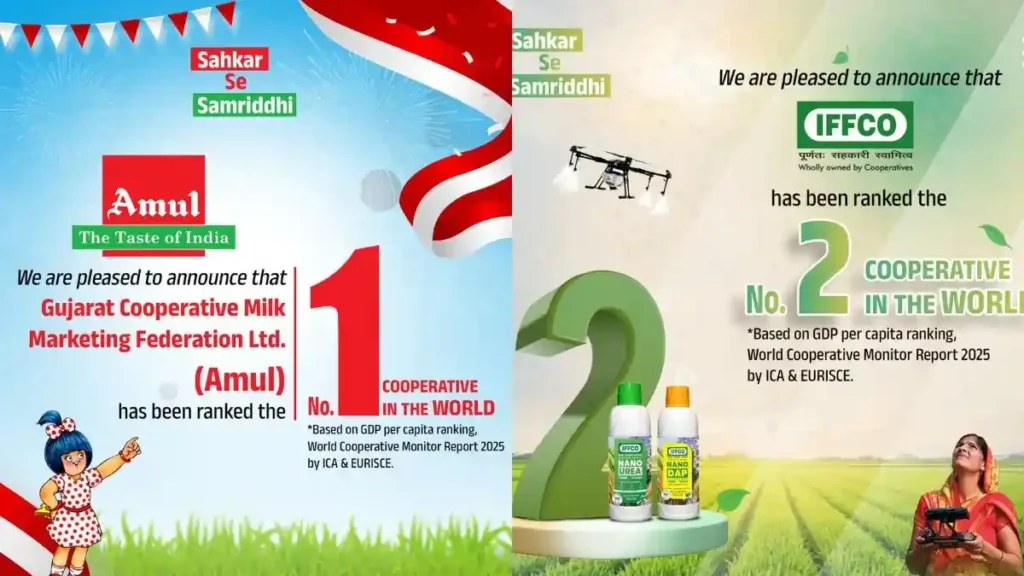New Delhi: In a groundbreaking achievement that underscores India’s dominance in the global cooperative movement, the Gujarat Cooperative Milk Marketing Federation Ltd (Amul) and the Indian Farmers Fertiliser Cooperative Limited (IFFCO) have secured the first and second positions, respectively, in the prestigious World Cooperative Monitor 2025. Released by the International Cooperative Alliance (ICA) at the ICA CM50 Conference in Doha, Qatar, these rankings highlight the unparalleled success of Indian cooperatives in driving economic empowerment, rural prosperity, and sustainable development.
Prime Minister Narendra Modi took to social media to extend heartfelt congratulations to Amul and IFFCO, emphasizing the vibrancy of India’s cooperative sector. “India’s cooperative sector is vibrant and is also transforming several lives,” he stated, adding that the government is committed to implementing numerous initiatives to further strengthen this vital ecosystem in the years ahead.

Decoding the World Cooperative Monitor 2025 Rankings
The World Cooperative Monitor, an annual report by the ICA, evaluates cooperatives worldwide based on a unique metric: turnover per capita relative to the country’s GDP per capita, alongside their adherence to core cooperative principles and measurable socioeconomic impact. This methodology ensures that cooperatives are not judged merely by financial size but by their efficiency, inclusivity, and contribution to community welfare.
For the 2025 edition:
- Amul (GCMMF) – Ranked #1 globally
- IFFCO – Ranked #2 globally
This dual victory marks a historic milestone, positioning India as the undisputed leader in cooperative governance and affirming the nation’s pivotal role in global food security, rural development, and inclusive economic growth.
The Indian Cooperative Ecosystem: A Legacy of Empowerment
A cooperative is defined as an autonomous association of persons united voluntarily to meet their common economic, social, and cultural needs through a jointly owned and democratically member-controlled enterprise. Rooted in principles of collective ownership, democratic decision-making, and equitable profit distribution, cooperatives have been a cornerstone of India’s rural economy for over a century.
Historical Genesis and Constitutional Backing
The cooperative movement in India traces its formal origins to the Cooperative Credit Societies Act of 1904, which laid the foundation for organized cooperative credit in rural areas. Over the decades, the sector has evolved into a robust network of over 8.44 lakh cooperatives — representing more than one-fourth of the world’s total cooperatives.
The 97th Constitutional Amendment Act, 2011, was a watershed moment, granting citizens the fundamental right to form cooperative societies under Article 19(1)(c) and introducing Article 43B in the Directive Principles of State Policy, directing the state to promote cooperative societies.
Legal Framework Governing Cooperatives
- Multi-State Cooperatives: Governed by the Multi-State Cooperative Societies Act, 2002 (amended in 2023)
- State-Level Cooperatives: Regulated by respective state or Union Territory acts
- Constitutional Placement: Listed under the State List (Entry 32) in the Seventh Schedule
Geographic Strongholds
The cooperative movement is particularly strong in:
- Maharashtra
- Gujarat
- Telangana
- Madhya Pradesh
- Karnataka
These states collectively host the largest and most impactful cooperative networks in the country.
Government Initiatives Fueling Cooperative Growth
The Indian government has consistently prioritized the cooperative sector through strategic institutions and policies:
- 1963: Establishment of the National Cooperative Development Corporation (NCDC) to provide financial and technical support
- 1982: Creation of NABARD (National Bank for Agriculture and Rural Development) to bolster rural credit and cooperative banking
- 2021: Formation of the dedicated Ministry of Cooperation under Union Minister Amit Shah
- 2025: Launch of the National Cooperation Policy 2025, a forward-looking roadmap to modernize and globalize Indian cooperatives
These initiatives align with the national vision of “Sahkar Se Samriddhi” (Prosperity through Cooperation), reinforcing cooperatives as engines of inclusive capitalism.
Amul: The Dairy Giant Revolutionizing Rural India
Headquartered in Anand, Gujarat, the Gujarat Cooperative Milk Marketing Federation Ltd — popularly known as Amul — was founded in 1946 by Tribhuvandas Patel under the guidance of Sardar Vallabhbhai Patel. What began as a rebellion against exploitative milk traders has transformed into a global cooperative powerhouse.
Operational Scale and Structure
- Geographic Reach: Operates across 33 districts in Gujarat
- Membership Base: Represents 3.6 million milk producer members, predominantly smallholder farmers
- Business Model: A three-tier cooperative structure:
- Village-level Dairy Cooperative Societies (collection and primary processing)
- District-level Milk Unions (processing and value addition)
- State-level Federation (GCMMF) (marketing and branding)
Key Success Factors
- Farmer-Centric Pricing: Ensures stable and remunerative prices regardless of market fluctuations
- Value Addition: Converts raw milk into high-demand products like butter, cheese, ice cream, and UHT milk
- Global Brand Recognition: Amul is now a symbol of food security, self-reliance, and cooperative innovation
- Digital Integration: Uses technology for transparent procurement, quality testing, and payment systems
Amul’s journey from a local dairy cooperative to the world’s top-ranked cooperative exemplifies how democratic governance and member ownership can drive both profitability and social impact.
IFFCO: Empowering Farmers Through Fertilizers and Beyond
Founded in 1967 as a multi-state cooperative society and headquartered in New Delhi, the Indian Farmers Fertiliser Cooperative Limited (IFFCO) has emerged as a lifeline for Indian agriculture.
Scale of Influence
- Farmer Reach: Serves over 55 million Indian farmers through thousands of member cooperative societies
- Core Business: Production and distribution of fertilizers, agrochemicals, and rural inputs
Strategic Pillars of Success
- Sustainable Manufacturing: Operates world-class plants with a focus on green technology and energy efficiency
- Digital Transformation: Pioneering use of mobile apps, drones, and AI-based advisories for precision farming
- Profit Reinvestment: Surpluses are channeled into:
- Rural education and healthcare
- Farmer training programs
- Climate-resilient agriculture initiatives
- Community infrastructure
IFFCO’s ability to blend commercial efficiency with social purpose has earned it the second global rank, validating its role as a model of equitable and sustainable agribusiness.
Prime Minister Modi’s Vision for Cooperative-Led Growth
In his congratulatory message, PM Modi highlighted the transformative potential of cooperatives:
“The government is taking numerous steps to further encourage this sector in the times to come.”
This statement reflects a broader policy push to:
- Strengthen cooperative credit and marketing systems
- Promote cooperative-to-cooperative (C2C) business models
- Integrate cooperatives into national supply chains
- Leverage cooperatives for achieving Sustainable Development Goals (SDGs)
Global Implications: India’s Leadership in Cooperative Diplomacy
The 2025 rankings coincide with the United Nations’ International Year of Cooperatives, providing India a unique platform to champion cooperative principles globally. At the ICA CM50 Conference in Doha, Indian delegates showcased how Amul and IFFCO align with:
- SDG 1: No Poverty
- SDG 2: Zero Hunger
- SDG 5: Gender Equality (via women-led dairy cooperatives)
- SDG 13: Climate Action (through sustainable farming practices)
This recognition elevates India’s soft power in cooperative diplomacy, positioning the country as a thought leader in inclusive economic models.
Why This Ranking Matters: Beyond Numbers
The World Cooperative Monitor does not rank cooperatives by absolute revenue. Instead, it uses a normalized metric — turnover per capita divided by GDP per capita — to level the playing field between developed and developing nations. This approach rewards:
- Efficiency in resource utilization
- Democratic member control
- Reinvestment in community welfare
- Adherence to the seven ICA cooperative principles
Amul and IFFCO’s top rankings validate that Indian cooperatives are not just large — they are impactful, resilient, and future-ready.
A Blueprint for Inclusive Capitalism
Unlike shareholder-driven corporations, Amul and IFFCO operate on the principle of “profits for people, not for profit”. Every rupee of surplus is either:
- Returned to farmer-members as bonuses
- Reinvested in capacity expansion
- Used for rural community development
This model directly contributes to:
- Poverty alleviation
- Rural employment generation
- Women’s economic empowerment (especially in dairy cooperatives)
- National self-sufficiency in milk and fertilizers
Looking Ahead: The Future of Indian Cooperatives
With the National Cooperation Policy 2025 now in motion, the sector is poised for:
- Digital modernization of cooperative databases and transactions
- Export-oriented growth for Amul’s dairy products and IFFCO’s bio-fertilizers
- Cooperative startups in renewable energy, e-commerce, and healthcare
- Global partnerships under India’s G20 and UN engagements
Key Takeaways from the 2025 Rankings
| Parameter | Details |
| Report | World Cooperative Monitor 2025 |
| Published By | International Cooperative Alliance (ICA) |
| Event | ICA CM50 Conference, Doha, Qatar |
| Top Rank | Amul (GCMMF) – Rank 1 |
| Second Rank | IFFCO – Rank 2 |
| Evaluation Criteria | Turnover per capita / GDP per capita + Social Impact + Cooperative Principles |
| Amul Membership | 3.6 million milk producers |
| IFFCO Farmer Reach | 55 million+ farmers |
| India’s Global Share | Over 25% of world’s cooperatives (8.44 lakh+) |
Conclusion: A Proud Moment for India’s Cooperative Spirit
The ascent of Amul and IFFCO to the top two positions in the World Cooperative Monitor 2025 is more than a ranking — it is a celebration of India’s cooperative ethos, farmer resilience, and democratic enterprise. From the milk collection centers of Anand to the fertilizer plants of Kandla, millions of rural Indians are writing a success story that resonates worldwide.
As Prime Minister Modi aptly noted, India’s cooperative sector is vibrant, transformative, and future-focused. With continued government support, technological integration, and global outreach, Indian cooperatives are set to lead the world toward a more equitable and sustainable tomorrow.
FAQs
1. What is the World Cooperative Monitor 2025?
An annual report by the International Cooperative Alliance (ICA) that ranks cooperatives globally based on turnover per capita relative to GDP per capita, along with their social impact and adherence to cooperative principles. It was released at the ICA CM50 Conference in Doha, Qatar.
2. Which Indian cooperatives ranked #1 and #2 globally in 2025?
Amul (GCMMF) secured Rank 1, and IFFCO achieved Rank 2, marking the first time two Indian cooperatives dominate the top spots.
3. How does Amul empower farmers through its cooperative model?
Amul operates a three-tier structure connecting 3.6 million milk producers across 33 districts in Gujarat. It ensures stable pricing, transparent payments, and value-added products, directly boosting rural income and food security.
4. What makes IFFCO a leader in agricultural cooperatives?
IFFCO serves over 55 million farmers through member societies, focusing on sustainable fertilizer production, digital farmer outreach, and reinvesting profits into education, green tech, and rural development.
5. How does the Indian government support the cooperative sector?
Key steps include forming the Ministry of Cooperation (2021), launching National Cooperation Policy 2025, and strengthening institutions like NCDC (1963) and NABARD (1982) to promote “Sahkar Se Samriddhi” (Prosperity through Cooperation).

